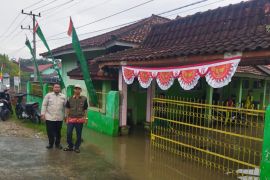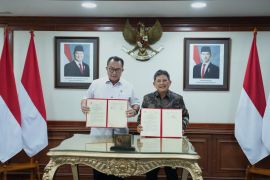When they showed me the design draft, I immediately expressed my discontent, as the torch design only integrated the Asmat group's indigenous pattern, and they only refer to the Internet search engine results to draft their initial designPapua (ANTARA) - Anthropologist of Papua Enrico Yori Kondologit unexpectedly received a call from an official of the PON XX National Games Torch Relay Committee during his flight to Klamono, Sorong District, West Papua, on July 1, 2021.
The official called him to enquire about the PON XX Torch design while noting that the torch must be completed prior to the torch relay scheduled from September 27 until October 2, 2021.
His expertise in Papuan anthropology attained during his masters study in Cenderawasih University, Jayapura, made him the right fit to seek inputs on the torch design and to give a verdict on whether the initial design proposal sufficiently represented traditional patterns and forms of the indigenous Papuan groups and customary regions.
“When they showed me the design draft, I immediately expressed my discontent, as the torch design only integrated the Asmat group's indigenous pattern, and they only refer to the Internet search engine results to draft their initial design,” Kondologit recalled his first impression of the proposed torch design.
Related news: President plays football with Papuan children at PON opening ceremony
He noted the initial design failed to recognize Papua Island’s seven customary regions of Mamta or Mamberamo-Tami, also known as Tabi; Saereri; Ha Anim; La Pago; Mee Pago; Bomberai; and Domberai within the provinces of Papua and West Papua.
After presenting his justification on the need to revise the torch design, the PON XX organizing committee expressed its consent over a design revision to be performed by Kondologit. He sought two to three days to perform the designing work.
With his educational background in Papuan anthropology, Kondologit, who concurrently serves as head of the Cenderawasih University’s Anthropology Museum, was able to complete the perfected torch design that integrated symbols from the Papuan customary regions on time.
Related news: Hockey national team coach to scout athletes during PON
Torch: emblematic of Papuan customary lands
The final torch design presented by Kondologit was richly adorned with patterns and symbols of Papuan customary lands, thereby symbolizing the unity of Papua as the PON XX Games host.
The patterns at the bottom of the torch are emblematic of the mountains and waves, representing the Mamta, Saereri, Ha Anim, Mee Paqo, and La Paqo customary society and portray respect to nature, prosperity, hope, and hard work.
Another natural feature engraved on the torch is the river pattern, representing the Asmat, Kamoro, and Malind Anim communities, symbolizing natural diversity, cooperation, family, responsibility, and values.
A centipede or leech pattern at the base of the torch signifies victory and luck in battle and journey and represents the Asmat, Kamoro, and Malid Anim ethnic groups from the Ha Anim customary area.
Related news: Sulaksana wins eight consecutive sailing gold medals in PON
Dragon snake, fern shoots, genemo -- a local plant used as a material for the traditional noken woven bag -- and coconut motives native to Saereri and Doberai represent persistence, youth, and growth.
A circle symbol from Sentani, representing the Mamta customary area, originated from a form of turtle -- locally known as ebeuw -- and a hornbill representing fertility, longevity, and patience. The torch design also integrated the totem and eye pattern from Yali La Paqo that represents the ancestor’s eyes.
“Shellfish and traditional nose piercing patterns are also integrated into the design to represent greatness, maturity, and responsibility,” Kondologit stated.
Hand-in-hand with West Java for the Torch
After the PON XX committee gave the green light for his final torch design draft, Kondologit then invited West Java artist Goy Gautama to create the PON XX torch. The Kamones Workshop & Gallery, owned by Gautama and based in Bandung, is one of the only two workshops holding exclusive rights to create the PON torches.
Related news: Minister urges effective utilization of sports facilities post PON
Gautama had received the mandate to craft the torch for major national competitions, and his latest major works were the torch for the 2018 Asian Para Games.
Kondologit affirmed that Gautama had spent a month to ready the PON XX torch prototype, with its final design then presented to the organizing committee in August 2021. The final design of the torch weighed two kilograms and was 70 centimeters in height.
“We often engaged in phone calls to discuss the torch design. Gautama lauded the torch's rich design that successfully blends the Papuan cultural spirit, and he was happy to incorporate the design into the torch,” the torch designer affirmed.
Despite the relatively smooth crafting process, Kondologit recalled that an official had attempted to tamper with the final design by suggesting a new color combination that had political connotations.
“I disagree with their suggestion, as this sporting event should be politically neutral. That is why I decided to combine only dark colors, wood carving, and brass motives into the torch design to prevent any political interpretations on the design,” he clarified.
Related news: PON record-breaking Murtiningsih advances to women's 100 m final
Upon completion of the torch, Gautama invited Kondologit to meet him at a hotel in Papua days before the torch relay to present the completed torch. Overwhelmed with joy, they exchanged personal souvenirs during the encounter.
“Gautama understood that I received no cash remuneration for the torch design and then he offered one of the 10 torches he had created for the Games to me,” Kondologit stated.
The torch designer reciprocated by presenting the artist a decades-old tifa – percussion musical instrument that is native to Papua – blanketed in lizard skin that was part of his personal collection. He recalled Gautama could not conceal his joy upon receiving the tifa.
The PON torch and fire are an essential part of the PON ceremony. The fire signifies warmth and sportsmanship values among the athletes and officials, and the games are commenced only after the flame cauldron is lighted by the torchbearer during the opening ceremony.
The PON XX torch-making process has united the provinces of West Java and Papua under the same goal, and the collaboration between the land of the bird-of-paradise and the abode of the Gods has been sealed and immortalized in the PON history.
Related news: KONI recommends billiards to become Papua's mainstay sport
Related news: Expert presses to bolster COVID-19 testing and tracing in Papua
Editor: Fardah Assegaf
Copyright © ANTARA 2021












